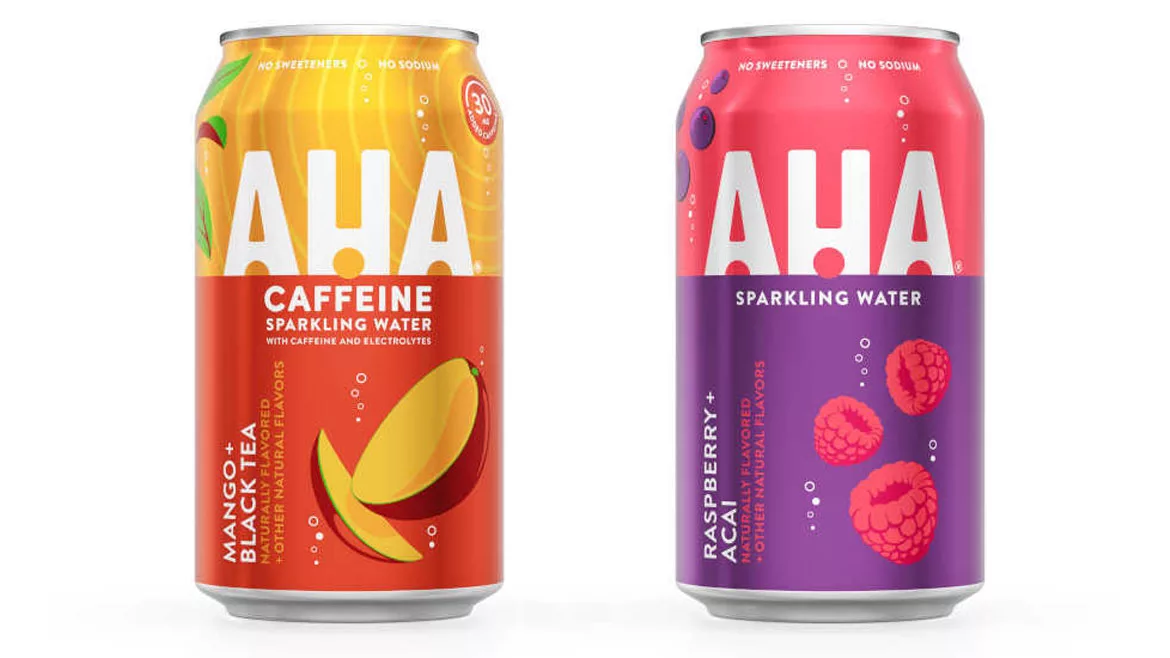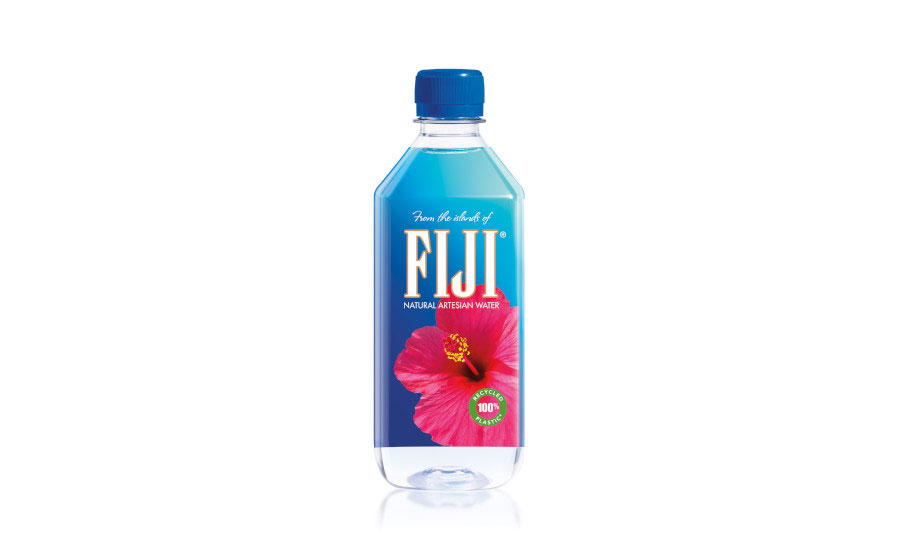Category Focus
Unit sales down, revenue up for water bottle sales
Various segments influenced differently by trends

Image courtesy of AHA Sparkling Water
In the summer of 2016, a strange trend emerged: bottle flipping. Videos of people, mainly kids and teens, flipping bottles partially filled with liquid, flooded the internet after teen Mike Senatore went viral for flipping a water bottle in his high school talent show. The goal was to flip the bottle into the air from its neck so that it landed upright on its base. With these half-full bottles — usually, bottles of water — participants quickly annoyed parents and teachers alike. Luckily, the trend subsided after a while, and water bottles everywhere were spared.
More recent — though, not viral — bottled water trends display a decline in unit sales. Data obtained by Information Resources Inc. (IRI), Chicago, shows that unit sales are down nearly 1% in the 52 weeks ending Sept. 4. Sally Lyons Wyatt, executive vice president at IRI, says this indicates “that gains to the category are due to price increases,” as the dollar sales of bottled water is up almost 13%.
Chairman and CEO of Beverage Marketing Corporation (BMC), New York, Michael Bellas, also notes that volume is slowing for bottled water while revenue accelerates. He suspects that the overall market “will likely show continued slow volume growth in the second half of 2022” and revenue growth will continue to be strong.
“Still water share is growing again due to a decline in domestic sparkling water performance, and will likely continue to hold on to its strong position for the remainder of 2022, with its share approaching 94-95% of the total water market,” Bellas says.
In the Mintel report titled “US Still and Sparkling Waters Market Report 2022,” key takeaways show that consumer interest in health and wellness has helped raise the water market. Especially with the return to social activities and travel, bottled water sales increased, the Chicago-based market research firm notes.

Image courtesy of FIJI Water
Trends that are making a splash
Walking down the water aisle at the grocery store, there are plenty of options from which to choose: flavored sparkling water, non-flavored sparkling water, bottled still water and so on.
IRI’s Wyatt considers non-flavored still water to be “the growth engine” of the overall bottled water category, with unit sales up almost 2% compared with other subcategories that are seeing a decline in unit sales.
“Dollar sales for bottled still water are also up the highest, at nearly 16%, followed by bulk still water sales of nearly 13%,” she says. “The rise of these two categories over the year could be an indication of more people drinking bottled water out of necessity, including seasonal hydration or lack of accessible clean water — think of the different communities that have had to resort to bottled water because municipal water supplies are compromised. However, we also see flavored waters continuing to gain sales, as they are a healthful and interesting beverage option.”
BMC’s Bellas says that, because of the pandemic, consumers have focused on healthier products, boosting the demand for bottled water ― especially at home. Meanwhile, specialty waters, such as alkaline and fortified water, have increased the category’s popularity.
“Unsweetened, fortified specialty waters have been a plus to the category, helping drive the growing premium sector of the still single-serve water market,” he says.
Wyatt adds that other alternate waters, like coconut, aloe and water extracts, are “showing mixed results in 2022.”
“Water extracts, the smallest — and newest — entrant, has sales of just more than $2 million, but is seeing growth of nearly 60% for the 52 weeks ended on May 15,” she says. “Coconut water, a subcategory with sales of nearly $512 million, has seen growth of just more than 12% for the same time period. Aloe water, with sales of $152 million, has seen dollar sales dip nearly 1%.”
Mintel’s report also suggests that water products “that go beyond hydration,” such as probiotic and relaxation waters, are making a splash, as well as new flavors.
| COMPANY | DOLLAR SALES | % CHANGE vs PRIOR YEAR | MAKET SHARE | % CHANGE vs PRIOR YEAR | |
| 1 | Private label | $4,579,875,240 | 24.6 | 32.3 | 2.2 |
| 2 | Aquafina | $1,295,774,110 | 12.9 | 9.1 | -0.3 |
| 3 | Glaceau | $1,083,076,048 | 12.8 | 7.6 | -0.2 |
| 4 | Dasani | $995,181,459 | 3.2 | 7 | -0.9 |
| 5 | Poland Spring | $864,613,825 | 14.7 | 6.1 | -0.1 |
|
|
Category Total* | $14,181,492,342 | 16.2 | 100 | --- |
*Includes brands not listed
Source: Information Resources, Inc. (IRI), Chicago. Total U.S. supermarkets, drug stores, gas and convenience stores, mass merchandisers, military commissaries, and select club and dollar retail chains for the 52 weeks ending Aug 24.
“Flavor innovation represents a key opportunity for brands to attract younger consumers, and unique flavors can allow water to compete with flavorful beverages such as [carbonated soft drinks] CSDs and sports drinks,” it states. “Floral and herbal flavored waters are trending, indicating opportunities for waters that blend familiar and trending flavors (e.g. blueberry lavender, watermelon mint).”
In terms of sparkling water trends, IRI’s Wyatt notes that new flavor mixes like black raspberry, blackberry lemonade, beach plum, pineapple blends and guava are contributing to the segment. The sweetener trend still is going strong “with zero sugar/sweetener, unsweetened, pure cane sugar and no sugar/sweetener being top claims,” she says.
BMC’s Bellas suggests that declines in the domestic sparkling water segment are due to higher prices “the cycling out of the rollout phase of the new brands from Coke and Pepsi.”
What’s the next wave for bottled water
With businesses and companies returning to the office, comes the need for bulk, home and office delivery (HOD) water. IRI’s Wyatt suspects that the demand will remain low due to the hybrid workforce. She also suggests that dramatic weather might impact the demand for HOD water.
However, another factor that could impact HOD sales is value, as bulk water purchasing can “stretch their dollars further,” Wyatt says.
“One would expect larger households to most likely make this shift given the cost of food is significant and the demand for hydration is highest in multi-person households,” she explains. “An external factor that may negatively impact demand is tap water. Home filtration systems are prevalent, but at times expensive. However, consumer adoption of home filtration is likely to increase as consumers see a positive ROI of such an investment versus buying bottled water from retail.”
BMC’s Bellas notes that HOD “is having one of its best years in 2022.” The bulk bottled water category benefits from “strong home consumption” and the opening of the commercial segment as we emerge from the pandemic.
“Its low, single-digit volume growth will likely be its best performance in over a decade,” he says. “Both the 5-gallon jug and dynamic small package water sizes are growing.”
Bottled water companies also are transitioning to different packaging, Bellas notes.
“There are more environmentally friendly package types entering the market, like paper and metal packaging,” Bellas says. “Additionally, rPET is becoming more prominent as well.”
Although IRI does not have survey data regarding the influence bottled water packaging has on consumers, Wyatt suggests that supply chain issues have impacted in-stock rates “and potentially pushed consumers to alternative options or reduced purchasing.” She adds that the sustainability factor has caused a drive for increased HOD sales.
Mintel’s report predicts that, in 2023 and 2024, “functional water product innovation will allow water to compete in new consumption occasions,” thanks to health-conscious consumers. Further, in 2025 and beyond, there will be “slow bottled water category attrition” because of increased environmental concerns and the loss of core consumers, it notes. The Mintel report indicates that higher-priced and premium water brands will compensate for the slowdown in bottled water sales.
Although it is difficult to predict the next big trend for water bottles, one can only hope that it doesn’t involve flipping again.
Looking for a reprint of this article?
From high-res PDFs to custom plaques, order your copy today!



